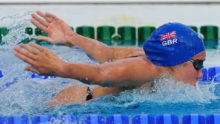
The differences between a track start and grab start in swimming
November 21, 2016Taken from his presentation at the ASA Masters Conference 2016, Loughborough coach Dave Hemming explains the differences between a track start and grab start in swimming.
Start your race the most effective way possible
When it comes to performing your best in the pool, it’s important to start your race in the most effective way possible.
Competitive swimmers typically use one of two positions on the block – a track start or a grab start.
A track start is where you have one foot at the front of the block and the other towards the back. For a grab start, a swimmer will have both feet at the front of the block.
You might associate a track start with a starting block that has an adjustable footrest towards the back. But the truth is, a track start is a more effective starting technique whether there is a footrest or not.
6 differences between a track start and grab start
The advantages of a track start are based on six differences between the two styles.
- Balance – having good balance on the block is essential to an effective start. It’s not hard to see how a track start helps this. With your feet spread, you have a wider base and better balance than the relatively narrow base of a grab start.
- Weight distribution – there are benefits to both a front weighted start and a rear weighted start. A front weighted start can help you leave the block quickly while a rear weighted start can help boost your acceleration and momentum off the block. The benefit of the track start position is that it allows for you to put your weight in either position. The grab start is much more fixed, with only a limited range to distribute your body weight.
- Tension – track starts also allow for an increased range of tension on the block. Many swimmers assume a streamlined entry to the water is from following your entry with your head. But an effective start involves whole body tension as you enter the water.
- Hips – a key feature of a good start is having your hips higher than your shoulders. Whether you are using a front weighted or rear weighted start, your hips will be elevated above your shoulders. A track start makes it much higher to raise your hips. The position of your hips in a grab start depends largely on your flexibility.
- Reaction – every swimmer wants as fast a reaction as possible to the gun. Swimmers using a track start can propel themselves forward from both their grip pull and their back leg. Grab starters can only use their grip pull.
- Time to streamline – in the time between starting and entering the water, you should be looking to adopt your streamlined position as quickly and efficiently as possible. It is much slower to get into this position from a grab start where you body is more compact and vertical.
How else can you improve your start?
Stability and flexibility are essential for the making the most of your start in swimming. Focus on building a stable position through your ankles, knees and hips.
Your feet should be around shoulder width apart with the toes of both feet facing forwards.
Is your back leg knee collapsing inwards? Correct this and work on building up your leg strength through squats and lunges
Is your back leg knee or toes facing outwards? Work on improving your flexibility and balance on the block by stretching your hamstrings and glutes.
 Masters Swimming Hub
Masters Swimming Hub



